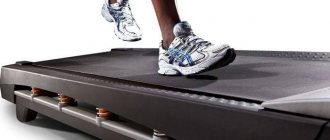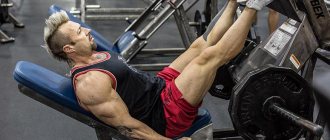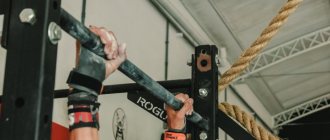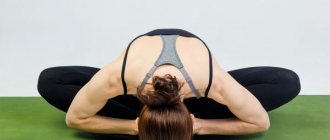Can't get up to the 3rd floor without getting out of breath? Tired of carrying extra pounds? Cardio will help you. But even such a seemingly simple thing must be approached wisely. People often choose the wrong strategies and do not get results, or lose weight along with muscles. As a result, they become frustrated and quit. Correct
cardio workout to burn fat- this is a whole science
. You need to know which cardio exercises to choose, how often and for what duration to do them. In this article, I collected a lot of research, my personal experience, and I willingly share my knowledge with you. Go!
The benefits of cardio training
Cardio training is the best thing you can think of to combat excess weight, increase endurance and get rid of negative thoughts. While running or swimming, you, of course, will not be able to set records for push-ups, but you will be ensured of vigor and the ability to spend a long time in motion.
What other benefits do cardio exercises provide?
- strengthening the cardiovascular system;
- respiratory system training;
- increasing the body's endurance;
- increased tissue density;
- muscle strengthening;
- lowering cholesterol levels;
- improving metabolism, that is, increasing metabolic rate;
- improving the ability of muscle tissue to process glucose, that is, preventing diabetes;
- production of endorphins and improvement of hormonal levels.
Cardio on an empty stomach
What is the best way to do cardio: on an empty stomach or after a meal? On the one hand, a study by Kaito Iwayama et al. [40] showed that fasted cardio in the morning significantly increased fat oxidation for up to 24 hours.
. A study by Kenshiro Shimada et al [41] indicated that fasted cardio oxidizes more fat, but at the same time stores more glycogen.
Other studies [42] show that cardio exercise
has a catabolic effect.
That is, along with fat, muscle proteins are used.
How to avoid catabolism? It's simple - drink BCAA before training.
They regulate protein synthesis, minimizing muscle damage [43], and accelerate fat burning [44].
Conclusion:
If you can do cardio on an empty stomach, do it after adding BCAA.
Contraindications
Most types of cardio training are available to a wide range of people, but if a person has any heart problems, has had a stroke or heart attack, then it is necessary to see a doctor before starting classes. The same recommendation applies to those who are obese, have diabetes, cancer, or have serious problems with joints and knees.
Whether it’s seemingly easy running or exotic canoeing, the duration and intensity of exercise should not be increased sharply. Start with light and short workouts, monitor your heart rate and stick to the rule of increasing the load by 10% per week.
Cardio exercises
Using moderate static cardio and HIIT techniques, you can perform various cardio exercises:
- normal walking;
- walking uphill;
- jumping rope;
- bicycle or exercise bike;
- cardio on the elliptical, rowing;
- swimming;
- boxing, kickboxing;
- martial arts (kendo, karate, taekwondo...);
- running (jogging, sprinting);
- cardio workout on the treadmill.
Essentially, cardio is any sustained activity that uses a large number of muscles.
. Therefore, it is not necessary to do cardio exercises only in the gym. Try running in place using the Tabata protocol - you'll tire yourself out.
Advice:
avoid stress on joints
(running, jumping), especially if you are obese. Better use a bicycle, elliptical, walking uphill, rowing, etc.
Walking
The healthiest and most natural form of activity is walking.
[45].
The body is designed to walk - our distant ancestors walked most of the time and looked great. Walking provides the same benefits as a classic cardio workout for burning fat. However, it does not have any disadvantages,
such as stress on the joints, risk of injury or overtraining.
How long to walk
? To burn fat and increase endurance, walk for at least 30-60 minutes, 5 days a week. In general, do this whenever possible.
Duration of cardio training
Whether you're looking to lose weight or improve your endurance, ten minutes of cardio won't cut it. The minimum recommended duration of cardio training is 30 minutes, which is the time when glycogen stores are depleted. However, do not forget that a previously untrained person can start with 10 minutes of exercise, gradually increasing the time to 60 minutes.
When losing weight, a long duration is important because the burning of fat deposits begins only after glycogen reserves are used up. To lose weight, you need to exercise either for a long time or intensely. In this sense, exercising in the morning on an empty stomach, when the body has low glycogen reserves, is good.
Training plans for marathon and half marathon. and start preparing today.
Important: you lose weight not because you exercise yourself, but because you create a calorie deficit. Together with exercise, this is much easier to bear, but do not forget to eat right to achieve the desired effect.
Workout 1
Ab crunches
Exercise for the rectus abdominis muscle
The exercise is performed from the starting position lying on the floor, the heels are spaced from the buttocks at a distance of 10-12 cm, the feet are literally pressed into the floor. You need to exhale to bring the lower ribs to the pelvic bones and return to the starting position.
Do 3 approaches 15-20 times. Over time, you can add weights - a dumbbell behind your head.
Hyperextension
Long back muscles, hamstrings, buttocks
The starting position is taken face down in the hyperextension machine. The body goes down, the spine is perpendicular to the floor. With exhalation - full extension of the torso, with inhalation - lowering down.
Perform 10-20 repetitions in three approaches; over time, you can increase the load by picking up a barbell plate and placing it behind your head.
Classic squat (barbell on back)
Works the buttocks, thigh muscles and center of the body
The barbell is taken from racks located at the level of the athlete’s collarbones. The bar lies just below the upper trapezius muscles so that the back can remain tense. The grip on the bar is tight; there is no need to bend your wrists back. As you exhale, the barbell is removed from the racks using extension at the knee joints, a step back is performed and the legs are spread to the sides. Next, the pelvis goes down with an exhalation, and the knees move to the sides and bend. The optimal depth of lowering of the pelvis is the one at which the back remains straight and there is no rounding in the lumbar region. You need to stand up with an exhalation, resting your entire foot on the floor.
If your heels come off during a squat, you need to pay attention to the width of your feet, pick up weights on the platform, and stretch your ankle joints. If the main problem is bringing your knees inward, you should work in a narrower stance.
Squatting training begins with calf extension in a machine, then a squat without weights, a goblet squat with an apparatus on the chest, work in a Smith machine, and finally a barbell. The goal of mastering this chain is to develop mobility of the knee, ankle and hip joints, as well as strengthen the muscles.
Block pull to the chest
Back muscles work
Starting position – sitting on a machine bench with your feet fully resting on the floor. Then, while exhaling, you need to begin to pull the shoulder blades towards each other and towards the spine, and by contracting the back muscles, bring the handle of the exercise machine to the chest, and then return it to its original position.
It is important not to start with your biceps, by bending your arms at the elbow.
Hip raises with barbell
Works the buttocks and hamstrings
You need to sit next to the bench, place your shoulder blades on it, and rest your feet on the floor. Then you should lift your buttocks off the floor and get into the “spine parallel to the floor” position. At the same time, the shoulder blades should not “ride” forward along the bench. You can hold the weight with your hands. Beginners sometimes learn this movement without a barbell before starting to use it. If placing the bar on your hips is not comfortable, you need to wrap it with a special pad, or use fitness mats.
Bench press
An assistant delivers the barbell from the racks to avoid injury. Even if it is a 20 kg bar, insurance is still required. The movement begins by tightening the shoulder blades and “pressing” the pelvis into the bench, then the assistant lifts the barbell onto straight, outstretched arms, with a grip slightly wider than the shoulders. Lower the barbell to the chest, in the solar plexus area, until it touches the body and the bar. The forearms are positioned at an angle of 45 degrees to the body. The barbell is pressed out in one powerful movement.
After completing all repetitions, an assistant helps return the bar to the racks. To avoid shoulder injury, you should not press on a “flat” back; your shoulder blades should remain pressed, not your lower back.
Standing Dumbbell Flyes
This is a shoulder exercise. You need to stand up straight, slightly bend your elbows, lean forward slightly, and abduct your forearms to the sides. As soon as the forearm reaches parallel level with the floor, the movement stops and the dumbbells smoothly return to their original position.
TRAINING PROGRAM in the Gym FOR GIRLS. FIRST LEVEL
Cardio intensity
The intensity of your activities can be monitored by your heart rate, which will be measured by a heart rate monitor. To achieve optimal cardiovascular performance, train between 60-90% of your maximum heart rate.
Maximum heart rate can be estimated by subtracting age from 220 - this is the simplest formula. For example, the estimated maximum heart rate for a 37-year-old person would be:
220 - 37 (age in years) = 183 beats per minute
Read on the topic: Pulse zones: what heart rate to run at
Stepper and other special simulators
The exercise machine allows you not only to lose weight, but also to stretch your buttocks, especially if a woman alternates walking vertically with an incline.
The glutes benefit from acceleration and strong resistance. With this cardio exercise, you will have to literally push down the steps with your heels. All three days of training must be moved at the same pace, performing the load according to plan for 40-50 minutes.
Another useful exercise machine for weight loss is the orbitrek. It imitates skiing, but acts elliptically, so it works not only the leg muscles, but also the shoulder girdle and torso. The load is considered non-impact, therefore it is safe for any age, but effective even with large body weight.
Alexander Shestov
TRX Certified Trainer
Ask a Question
Interval modes in any exercise equipment must take into account individual parameters that are set in the programmer. Normal activity should not exceed 60 minutes and the upper limit of your heart rate.
When is it better to do cardio: morning or evening
The time of day at which it is best to train depends on the goals of the practitioner.
The morning is suitable for those who want to lose weight, because during the night almost all of the glucose has been used up, and the body will quickly switch to fat burning. Morning cardio is very invigorating, unless you find it painful to get out of bed early.
Daytime exercise strengthens the heart. At this time, since the person has already eaten more than once, the body has enough nutrients and energy. But the body can switch to a fat-burning mode only 30-40 minutes after the start of the lesson.
Evening activities can be similar to morning and afternoon ones: it all depends on when you eat. To lose excess weight, at least 1.5-2 hours should pass between cardio exercise and meals, and after training it is better to eat food that does not contain carbohydrates.
Training program for gaining muscle mass
Exercises that promote muscle development are necessary not only for men; they are useful for women to form a sculpted figure. The plan aimed at developing muscles is almost the same for people who have just come to the sport and for those who have been doing it for a long time. It differs only in the number of repetitions and the weight of the weights.
The plan for stimulating muscle growth looks like this:
- Monday: floor press, deadlift, overhead pull-down, pull-ups.
- Wednesday: squats, lunges, alternate leg abductions, butterfly.
- Friday: parallel bars press, deadlift, biceps curl, weighted squats, dumbbell fly.
The number of repetitions for physically unprepared people should not exceed 12 times in 3 approaches. More experienced athletes need to do each exercise 20-25 times in 3-4 approaches. When working with sports equipment, beginners should perform all exercises under supervision and pay special attention to safety precautions.
Types of Cardio Training
Run
Running is the first thing that comes to mind when talking about cardio. Indeed, this is the most accessible and simplest type of cardio exercise. However, it is important that the student does not have problems with his knees, and that he runs in shoes suitable for this. Running either on the street or on a track in a fitness club will be equally beneficial for the body, but it is more pleasant and best to run in a forested area on the ground.
If you haven't run before, start with 20-minute sessions, alternating between walking and running. When you cross the threshold of 10 minutes of continuous running, add 1-3 minutes to it. To improve your health, three workouts a week will be enough.
Health running: benefits and contraindications
There is also a fun and time-saving option in running – canicross, or running with a dog. You still walk your pet in the morning and evening, so why not replace the walk with a run? Most dogs will definitely be happy with this transformation of their walks.
Cross-country skiing
Don’t want to run in winter and don’t want to stop doing cardio? Cross-country skiing is the way to go. Of course, you will have to spend more time on a ski lesson to get to the ski track, but how fresh it is in the forest in winter!
Unlike running, this type of cardio has a low impact factor on tendons, ligaments and muscles, so it's not that easy to get injured from overuse. Skiing is also good because it uses not only the lower body, but also the upper body, and therefore it is an excellent comprehensive workout for the whole body.
Considering the fact that in Russian cities there are no ski tracks in every park, most likely you will be able to go on a ski trip no more than twice a week. Therefore, think about what other type of affordable cardio you should choose for weekdays.
Bike
Cycling beats all types of cardio workouts by adding an element of travel to your workout. On weekends, if you have enough riding experience, you can easily go out into nature outside the city, receiving a lot of positive emotions from getting to know new places.
When you pedal, your bones and joints are not subject to repeated shock. Well, to spin them, you don’t have to buy a bicycle, worry about its serviceability during operation, ride around the city or wait for suitable weather. You can “ride” a bicycle in the fitness room or at home, using an exercise bike or machine. The effect on the body will be the same.
How to choose a bike station for training at home
Cycling
At first glance, cycling is similar to cycling, but the difference between these two types is about the same as between running and skiing. In cycling, the load, in addition to the legs, goes to the upper body.
Cycling is intense cardio, so it is not recommended for people with diseases of the cardiovascular system. For beginners who get off the couch, it will be difficult in the first classes; to begin with, it is better to get by with a calm type of cardio training.
Due to the high intensity of cycling, classes 2-3 times a week will be enough for you. Read more about it in the article: What is cycling and can it replace cycling?
Walking
Walking is the best solution for people with heart disease, obesity and for those who cannot find time to exercise. Agree, you can just take a walk during your lunch break, walk the dog longer, get off 2-3 stops earlier, or park your car further away. Over the course of the day, an hour of walking will accumulate, that is, an average of 5 kilometers.
Walking: types, benefits, calorie consumption
You can and should walk every day: there is no high load on the heart, joints and muscles. For the best healing and fat-burning effect, try to walk quickly or alternate between fast walking and walking that is comfortable for you.
Walking option - Nordic walking. It involves up to 90% of the muscles and is considered very effective for healing and losing weight. This is not the case with running or cycling. But to use all these muscles, technique is important when walking with poles. To do this, take 5-7 lessons from an instructor.
Jump rope
Jumping rope is an affordable home workout that will build endurance, strengthen muscles and improve coordination. For those who run, jumping rope is a good way to practice cadence and reduce foot contact time.
The main problem with a jump rope is that jumping for more than 5 minutes is boring, but the effect of cardio begins only after 40 minutes! In this regard, a jump rope can become an addition to training, but not the main type.
For example: twice a week you can go to a cycling studio, and 1-2 times a week jump rope at home. Various training complexes will help to diversify your jumps, including jumping on one leg, push-ups, burpees, and squats.
Jump rope for runners: benefits, technique, training
Swimming
Swimming in a pool or open water spares your joints and tendons the wear and tear that comes with many other workouts. However, swimming uses a lot of muscles without forcing a person to go to high intensity. You can keep your heart rate in the aerobic zone for a long time without getting as tired as, for example, skiing.
The benefits of swimming: 20 reasons to go to the pool
However, if you want the effect of classes, forget about long breaks at the side. It will be better if you can swim without stopping. Swimming has many techniques - crawl, breaststroke, butterfly, backstroke - and they all put more or less stress on certain muscle groups. If you pay attention to a specific technique in each workout, you can comprehensively develop your body.
For runners, skiers, and cyclists, swimming is the best recovery workout. Calm swimming allows your legs to rest and relieve muscle soreness faster.
Ellipsoid
The movements on the elliptical trainer are similar to running and skiing at the same time. Exercises on this equipment involve almost all muscle groups - up to 80%, and due to the elliptical trajectory of movement there is no high load on the joints. If you didn’t know, you can pedal backwards on an elliptical, putting a strain on muscles that are not so easy to work in other types of cardio.
A noticeable advantage of the ellipsoid is that you do not need to specially learn the technique of movements - the amplitude of movements on it is preset.
Rowing machine
Rowing is available to just a few, and a rowing machine with a countdown of the distance traveled and power will meet you in most modern fitness clubs. This is both cardio and strength training, which involves the muscles of the arms, legs and back, according to various sources, from 80 to 95% of the muscles.
A rowing machine can build endurance and strength in a way that running, walking and cycling cannot. In general, in terms of the load on the human body, it is very similar to skiing. The rowing machine keeps your heart rate at a moderate intensity, and 20-60 minutes of high-intensity exercise 3 times a week will be sufficient.
Crossfit
Functional training, developed by the CrossFit corporation, is now at the peak of popularity, because it is not for nothing that the word “CrossFit”, which is a brand, has become used everywhere when it comes to combining cardio exercise with gymnastics and strength exercises.
CrossFit is a circuit training where you need to complete a certain complex while spending as little time as possible. These are high-intensity workouts, and you should only approach them if there are no contraindications to long-term work.
There are so many different exercises for endurance, strength, and flexibility in CrossFit that the trainer will offer you something new at every lesson. But if you are very passionate about these workouts, it is advisable to still give yourself a day of rest before your next visit to the gym.
Water aerobics
Water procedures are not only about swimming. Water aerobics is created for those who quickly get bored of swimming from side to side. Water aerobics classes take place in a swimming pool under the guidance of a trainer who shows the group the exercises to music.
Since all this is done through the resistance of water, the muscles also receive sufficient stress. Water, in addition, here acts as support for the musculoskeletal system, reducing unnecessary stress on it. Water aerobics is one of the most non-traumatic types of human physical activity.
Despite the fact that water aerobics exercises involve almost all muscle groups, muscle tension is relieved in water, so such training will be a good addition to basic cycling/skiing/running and other training on land.
Step aerobics
Step aerobics has all the benefits of a high-intensity cardio workout without the stress on your joints. During the classes, a height-adjustable step platform is used, on which various choreographic combinations of steps are performed at a fast pace. Dumbbells can also be used to increase the load.
Step aerobics refers to cardio, where the load throughout the entire session is above average: you cannot stop for 45-60 minutes, rest in the form of a step in place is given after a set of intense steps.
As for working muscles, in step aerobics the main emphasis is on the lower body. To improve your body comprehensively, you will need separate exercises for your arms, chest and abs.
Fitbox
A mixture of martial arts, strength training, aerobic exercise, a self-defense lesson - all this is a new type of fitness called fitbox. Punches and kicks on a punching bag are done at an accelerated pace to rhythmic music, which causes the pulse to accelerate to the anaerobic zone, which trains physical endurance.
Fitbox is somewhat similar in structure to cycling: the trainer forces the group to constantly move and perform strength exercises between hitting the punching bag.
Don’t be afraid to go to fitbox training: unlike regular boxing, there is no sparring, which means there is no pain, bruises and abrasions.
Ski simulator
Classes on a ski simulator can be either a year-round addition to cross-country skiing or an independent form of physical activity. One thing is for sure: the ski trainer will get your heart racing very quickly. The whole body will be involved in the work: the hands here pull the rope, the hips and knees bend to push, the abs hold the torso.
Unfortunately, ski simulators are not common in Russian fitness clubs, but a good replacement can be a ski expander - a sports equipment in the form of a cord with handles, which can be used either in the gym or on the playground near the house.
The expander is also effective because it can be used to perform exercises that not only imitate skiing, but also any other exercises to strengthen different muscle groups. 25-30 minutes of such training 2-3 times a week will be enough.
Rock climbing
It would seem how far rock climbing is from cyclic sports that act as cardio engines, which, however, does not prevent the heart from beating faster when climbing.
Rock climbing in the mountains is a difficult and technical sport, but climbing indoors at a climbing wall is accessible to everyone, even those who are afraid of heights. Rock climbing requires dexterity, coordination, strength of arms, legs, and in general, while climbing, a person constantly tenses the muscles of the body, so it is even similar to running.
Only, unlike running and cycling, in rock climbing the upper body does not receive even the slightest rest, and the alternation of a concentric load mode (holding a pose) and an eccentric load (moving) awakens to work even those muscles whose existence you did not suspect. On average, you can spend 500 kcal per hour at the climbing wall.
As a comprehensive full-body workout instead of weights in the gym, this is a great option that also involves the brain in the work. Completing a climbing route is like a game of chess.
Stair running or walking
Walking or running up the stairs is available to residents of multi-storey buildings at any time of the year and in any weather. This load is much more intense than regular jogging, and the heart rate will most likely remain in the aerobic zone throughout the session, improving cardio endurance.
Running up the stairs is both a strength and cardio workout. In this case, the high impact is not only on the heart, but also on the leg muscles. Thanks to the stairs, your legs will become much stronger than they could become from regular flat running.
Stair running for 10 minutes 3 times a week already after 6 weeks gives a significant increase in general functional indicators - heart rate, recovery time, breathing rate, exercise tolerance. Like cycling, walking and stair running are considered moderate to above average cardio intensity, so three sessions per week, if there are no others, will be enough.
Stair running: recommendations and training plan
Coordination ladder
This sports equipment is often used in training football players, basketball players and skiers. The coordination ladder forces a person to make a burst of speed while at the same time controlling balance, agility and coordination.
Given the explosive nature of the work, the load from such equipment with limited rest between intervals will be above average. You can run through such stairs in different ways: forward, sideways, jumping, cross-step. All of these different variations of the exercise will help you avoid burnout and plateau in your form.
The simulator does not take up much space, you can exercise with it anywhere.
Skating
In winter, cyclists are recommended to do speed skating, which uses the same muscle groups. If you don’t know about this, then it won’t even occur to you that cycling and speed skating are so similar: by the way, they switch from skating to cycling quite often.
Not to say that this is a mass sport, but, nevertheless, in the winter season in Russian cities there are quite a lot of flooded ice skating rinks, where you can rack up kilometers in a circle. As a cross-training option, speed skating will help add variety to your core training program and improve your balance and coordination.
Football, basketball, volleyball, tennis
We included these game sports in the selection because during the game a person is in constant motion: he runs across the entire field, jumps high, and uses the shuttle running method. The heart rate here will probably be even higher than during a calm ski walk in the forest.
Basketball, tennis and other outdoor games train agility, flexibility, coordination, and reaction along with endurance and speed. It cannot be said that team sports have a positive effect on a person’s character, tactical thinking and social skills.
Dancing
Dance training is far from routine. Such classes are always held in a group or with a partner, and therefore sometimes you don’t notice how time flies. Cardio dancing provides an aerobic workout for the entire body, toning all muscle groups, helping to avoid imbalances.
Working the same muscles over a long period of time creates stress tolerance, so that you gradually stop getting as good a workout as you once did. But dance movements are different in that they are constantly different and do not use the same muscles to the point of exhaustion.
Let's add that dancing improves your mood. In one study, depressed patients were given salsa lessons for 9 weeks. At the end of the experiment, everyone experienced an uplift in mood. The researchers attribute this to the fact that it was the combination of social interaction, exercise and concentration required to master a new skill that significantly improved the mood of all study participants.
From our selection, you understand that cardio does not end with running, cycling and swimming. You are free to engage in any type of activity, combining them, which will make your workouts varied and your body fully developed. Most importantly, do not forget about recovery, healthy eating and safety measures.
Read more: Which is better: running or cycling?
Cardio training for fat burning: how to do it right
1 Start with light loads
As with any type of physical activity, start cardio training with easier options. This will help avoid injuries and premature burnout. Easy 10-minute runs at a moderate pace, or even regular walking if you have injuries or a lot of excess weight. Doctors recommend physical activity for obese people - daily walks. And only after some of the weight is gone, you can start running training. But even if you only have 10-20 kg extra, you still need to increase the intensity of your training gradually.
2 Train within your calculated maximum heart rate
The higher the heart rate at which you exercise (the higher the intensity), the more calories you burn. But if you go beyond the maximum (220 minus age), you risk injury.
3 Maximum duration of cardio training – 45-60 minutes
No matter how much you would like to quickly get rid of excess weight, cardio training lasting more than 60 minutes will lead to the opposite effect. You risk getting injured - which will prevent you from training for some time. You will burn muscles - which are so important for getting a beautiful figure. If you want to maximize fat burning, combine cardio and strength training.
4 Exercise regularly
If you want to get the effect, train 3-4 times a week and with sufficient intensity (according to your level of training) - don’t slack off! The mere fact that you are at the gym is not enough. You need to make an effort to get results. For beginners, 3 cardio workouts per week for 45 minutes may be enough to burn fat (if you do strength training, less). But to increase endurance, you need to train more often/more intensely.











